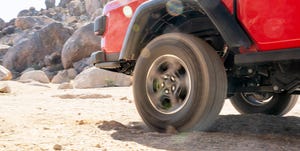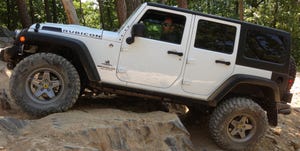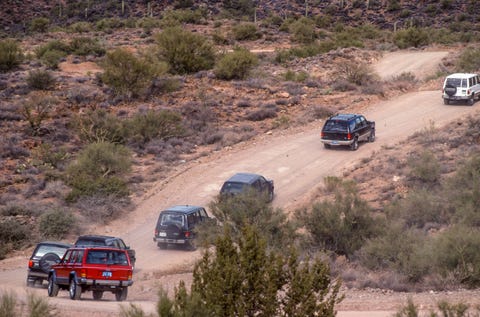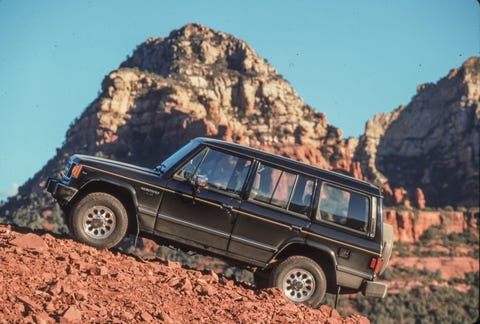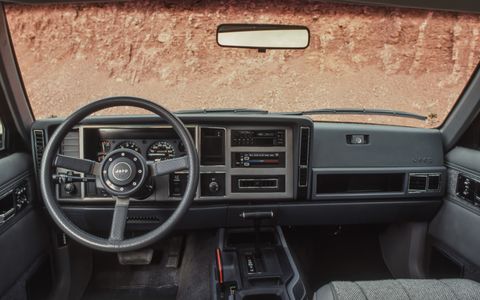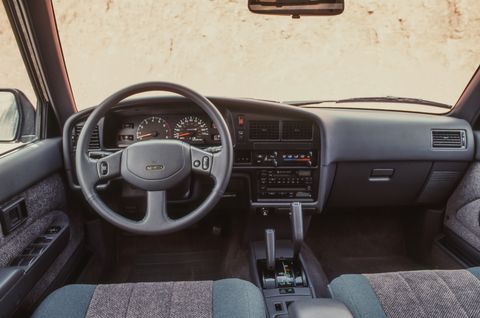From the April 1990 issue of Car and Driver.
Sport-utility vehicles are nothing like Brussels sprouts, except in one respect: either you just naturally love the little beasties or you can’t quite grasp what other people see in them. Both of these views, as matters of personal taste, are entirely valid. And each, it turns out, is well represented within the ranks of the Car and Driver editorial staff. That’s a good thing, because it meant that a three-day, seven-vehicle expedition in the deserts and mountains of central Arizona would lead to spirited discussion, conscientious judgment, and clear-cut conclusions about today’s highly competitive crop of mid-size, four-door, all-wheel-drive sport-utility machines.
Fans of these truck/station-wagon hybrids applaud the vehicles for their ruggedness, their go-anywhere capability, and especially their wide-ranging versatility. You can load these machines with anything from mothers-in-law to mining gear and head off for the corner store or the Continental Divide. Three-quarters of a million new sport-utility vehicles (SUVs) found homes in 1988, and the buyers were a diverse lot that included hard-core truck guys and family types looking for a safe and roomy sedan alternative. The category shows every indication of continued growth too, with more buyers, more models, and more marques (even Oldsmobile, for heaven’s sake) flooding into the marketplace.
At the same time, skeptics are absolutely right when they observe that almost all SUV drivers spend most of their time on perfectly good paved roads. Many modern four-wheel-drive trucks never see a mud bog or a rocky stream bed in their lives. And if it’s just snow you’re worried about, well, there are four-wheel-drive passenger cars at almost every price level. So in a real sense, these do-anything SUVs have compromised their on-road ride and handling in favor of a task they perform only rarely. Maybe never. Is that a sound approach to engineering personal transportation? Is it a reasonable concession to make in purchasing a family car?
Those inclined to like SUVs will say, sure, it can be a good trade-off—if the engineering is carried out skillfully enough. Those unenlightened to SUVs’ innate appeal will say, I dunno, these things still have to function as automobiles.
And that gives us the makings of a revealing comparison test. How do SUVs function? How well have they been engineered? How effectively have various manufacturers handled the compromises? In short, how do the players in this league really stack up by hard-nosed road testers’ standards?
We put seven editors in seven SUVs and sent them out over 350 miles of freeway, back road, dirt track, and creek bed to get the answers.
Our field comprised the seven SUVs that fit between the lightweight Sidekick-class funmobiles and the prestigious Range Rover-class heavy hitters. We specified four doors, six-cylinder engines, and automatic transmissions across the board. In alphabetical order, here’s the group: the Ford Explorer Eddie Bauer, the GMC S-15 Jimmy SLX, the Isuzu Trooper LS, the Jeep Cherokee Laredo, the Mitsubishi Montero LS, the Nissan Pathfinder SE, and the Toyota 4Runner SR5. And here they are again, in the order that emerged after our editors had their way with them and scored them on their overall goodness.
Seventh Place: GMC S-15 Jimmy SLX
For the 1991 model year, General Motors’ popular SUV has grown a second pair of doors, and it comes in your choice of badges: GMC, Chevrolet, or Oldsmobile. Obviously, it offers increased space and versatility over the two-door version, but it still doesn’t feel finished to us. The 4.3-liter Vortec V-6 puts out good power (160 horsepower, the second-highest rating of this bunch), but it’s a rough son of a gun that manages to be unobtrusive only at lightthrottle cruising. Any other time, from idle to full grunt, it feels and sounds like a V-8 with two plug wires pulled—not surprising, considering that it was created by slicing a pair of cylinders off GM’s small-block V-8. The Vortec V-6 is also one of only two engines in this group (the other being the Trooper’s GM-supplied 2.8-liter six) that still have their fuel injectors up in a throttle-body instead of right down in the intake ports.
Compared with its two-door siblings, the four-door Jimmy’s 6.5-inch-longer wheelbase (to 107.0 inches, the longest in our group after the new Ford Explorer) gives it a much smoother, calmer highway ride—one that compares well with the other SUVs in this test. But that’s the easy part. As soon as the surface turns rough, rutted, or rocky, the S-15’s chassis behavior gets ragged, with more leaping and banging than we’d like.
Most of us judged the Jimmy’s basic driving position to be very good, but we were also in agreement on two negative scores: the seats are too flat and weakly cushioned, and the instrument cluster should have simple, readable dials instead of swoopy video displays.
To its credit, GM has blessed its four-door SUV with anti-lock control for all four brakes (the ABS works in two-wheel-drive mode only). In this group, the Cherokee is the only other vehicle to offer four-wheel ABS (its system is able to work in full-time four-wheel-drive mode); the Explorer and the 4Runner have rear anti-lock brakes, the other no ABS. And GM has still held the Jimmy’ price, at just over $20,000 as-tested, solidly in the bottom half of this field.
So, yes, there is something to like about the bigger Jimmy: it fulfills the SUV’s basic promise of versatility. But even a brief look around this competitive market makes you wish the world’s largest automaker had focused its vast engineering resources on engine and chassis refinement instead of on gas-gauge graphics.
Sixth Place: Isuzu Trooper LS
One of the first SUVs to offer four doors and one of two—along with the Montero—of the “high boy” utilitarian school, the true-blue Trooper goes about its chore diligently and puts smiles on the faces of its many loyal supporters. But as other, newer players have entered this game and pulled the standards for the class toward more car-like comfort and refinement, the Trooper has begun to look a little agricultural.
On the upside, the Trooper’s tall, boxy shape is highly efficient—it has lots of capacity in relation to its footprint on the road—and is especially generous in the headroom department (though its tight 65.0-inch width is less considerate of elbows). With its emphasis on the utility side of SUV talents, the Trooper is a tough and capable off-roader that seems more and more at home as the terrain grows rougher. Also, everyone liked its silky, variable-assist power steering and the smoothness of its 60-degree V-6 engine (though more sheer urge would be nice). And the Trooper is obviously well put together and neatly—if somewhat simply—finished.
Unfortunately, the pavement ride is a little stiff, the tall profile gets to heeling in the corners, and there’s just no pretending this is anything but a truck. With the second-lowest sticker price of the bunch (undercut only by the remarkable Explorer), the Trooper represents fine value, particularly to those buyers who actually envision a significant amount of off-pavement duty for their SUV. For most others, however, something more car-like probably looks better, and Isuzu agrees: the Trooper will shortly be retired in favor of a wider line of more modern sport-utility wagons.
Fifth Place: Mitsubishi Montero LS
The Mitsu and the Trooper have nearly identical box scores, and for good reason. They are kindred souls, both taking the “civilized farm implement” approach, accepting the aesthetic minuses along with the pace-utilization pluses that entails. Thus many of the Trooper’s general comments also apply here. A markedly stronger engine (with no sacrifice in smoothness) raises the Montero’s daily livability, though, and allowed it to nose ahead of the Trooper.
Almost every driver commented on how comfortable and quiet the Montero was in freeway cruising, and everyone found it sure-footed off the pavement as well. A few nits were picked, though: the driver’s seat (a controversial suspended unit that gets to pumping up and down on certain rolling bumps) should slide back a bit farther to accommodate long legs, the truck-style manual-adjust outside mirrors seem rather retro, and dirt-road running set up a fair old ruckus, between interior rattles and suspension racket. Then there were the expected concerns over the bolt-upright seating and tippy cornering that are part of the deal in the tallest vehicle of the bunch.
The Montero still has its inclinometer, which most of us find either amusing or bemusing. It also has the largest sunroof in this universe, allowing back-seat passengers to stand up on a whim and give the crowd a regal wave.
Fourth Place: Jeep Cherokee Laredo
When the masses want to apply a term—generically and lower case—to what they consider an off-road vehicle, ”jeep” is the name they use. And that tells you something. By acclaim, the Cherokee is a tough, do-it-all wagon, and the whole world recognizes its heritage. But this has become a tough battlefield, and the tactics are changing quickly. So even if the Jeep is in some way the standard-bearer for this class, the charge is now running well ahead of the colors.
On paper, the Cherokee has a lot going for it: the strongest engine (177 horsepower), the lightest overall weight (3652 pounds), and four-wheel ABS. Its transfer case is also the only one in the group with an inter-axle differential, which permits running in four-wheel drive on hard, grippy surfaces without disengaging the ABS or straining the driveline (useful when conditions change between wet and dry or clean and dusty). And most of the Jeep’s logbook entries praised its ride and handling, its structural integrity, its ability to put power to the ground whatever the surface, and its general comfort. Apparently, its reliance on a solid axle up front, the only non-independent front end left in this group, did not handicap the Cherokee. Instrumented testing confirmed our impressions: the Jeep took a bunch of top honors—zero to 60mph in 10.5 seconds, a 107-mph top speed, 17.7 seconds at 76 mph in the quarter-mile—and a solid second place 0.70 g on the skidpad.
But we had some reservations, too. The over-assisted, zero-effort, zero-feedback steering comes out of another era—and should go back there as soon as possible. The front seats, reminders of the Franco-American Renault Alliance, are really only comfortable for passengers who fit within their snuggish shape. The Cherokee’s back seat is cramped and particularly hard to climb into because of the intrusive rear wheel wells (a result of its very short wheelbase). The instrument panel has started looking awfully old. Our Cherokee avoided being the most expensive vehicle in the group by a mere 164 bucks (thanks, Toyota). And the old fears about the small bits’ reliability have not been put to rest: our driver’s-seat recline lever came off, and the spare-tire fixing nut continually backed off.
It seems proper that the venerable Cherokee finished dead center in our ratings. From there, it anchors the field, pulling the stragglers along as it keeps the leaders in sight.
Third Place: Toyota 4Runner SR5
Here we’ve moved into the subgroup of modern sophisticates, and the talent deepens as the competition intensifies. Imagine a comfortable, fully equipped sedan that has been given compact-station-wagon proportions and then been jacked up in the air to take a “tough truck” stance. That’s Toyota’s 4Runner.
One liability of the layout is an unnaturally high floor, which demands an athletic climb into the cab and provides a low-seat, feet-straight-out driving position that feels odd at first. The look, too, doesn’t please everyone. Toyota may have correctly identified its customers’ preferences, and certainly we have no quibble with the rounded and cleanly contoured sheetmetal, but the sky-high image just isn’t us. We seriously doubt that a two-inch drop would rob much real ground clearance, and we think it would greatly improve the 4Runner’s appearance and convenience.
A back seat that cramps adults was all anyone found to complain about inside. Otherwise, the Toyota’s gracefully styled and supremely readable instrument panel, its fine quality of materials and assembly, and its high level of equipment (a CD player, even) made this the most attractive interior of the bunch.
For chassis performance, the 4Runner earned a high B-plus. Wheel motion seems well damped over washboard surfaces—flexible enough to walk through deep ruts and reasonably well isolated on the highway—but the 4Runner clearly falls a bit short of the high ride-and-handling standards set by our winner.
Everyone wished for more engine power, too, and the 4Runner’s highest of the high as-tested price of$25,779 hurt it in the value judging. But all our drivers enjoyed being at its wheel, and most commented they could live with the tall Toyota quite happily—but for the presence here of two other vehicles.
Second Place: Ford Explorer Eddie Bauer
Being new doesn’t always mean being best, but Ford’s Explorer is the only truly new vehicle in this class, and it does claim several key distinctions: it has the longest wheelbase (111.9 inches), the heaviest curb weight (4336 pounds), the most spacious seating, and—get this—the lowest sticker price here (a carefully estimated $19,400). True, it has a lot of Bronco II pieces under its skin, but the Explorer is so fresh and so good in the way the Bronco II never was that you just don’t care where Ford got the hardware.
A new 4.0-liter version of the old Cologne-built 2.9-liter V-6 powers the Explorer—and moves the hefty machine very effectively, with a touch of vibration now and then but plenty of response. The transmission feeds torque through the neatest-to-operate transfer case we’ve ever seen, which simply has two soft-touch buttons on the dash: one to engage four-wheel drive, the other to select the 2.48:1 low range.
Suspension bits recognizable from the Bronco II provide a soft, luxurious on-road ride, which still manages not to go completely to hell off the pavement. The Explorer does feel weighty and can float around a little on dirt roads, but the chassis swallows impacts well and maintains good poise. Steering that borders on being too light and too isolated nevertheless works just fine.
Our test crew raved about the Explorer’s spacious, well-designed, and neatly trimmed cabin. You sit low behind a high dash panel, but a very low beltline and tall windows keep you from feeling that you’re in the bottom of a bucket. And that panel carries a cluster of legible instruments right where you want them. Perhaps best of all, everywhere you touch—seats, controls, door panels—you’re rewarded with a quality feel, thanks in some part to the leather-lined luxury of our Explorer’s Eddie Bauer trim package.
This handsome new Ford fun wagon almost looks as if it should run with the big boys in Range Rover Land, yet it drives easily and lightly to the touch. Think of it as an SUV limousine, an up-to-the-minute interpretation of what these machines are supposed to be good for. Particularly at the price, Ford appears to have nailed one here.
First Place: Nissan Pathfinder SE
No one in this test hit the mark the way Nissan did. The original two-door Pathfinder set new standards for style and drivability among SUVs, and now this one paces the four-door field.
The new Pathfinder perhaps looks less striking than its two-door sibling, if only because it lacks the two-door’s distinctive triangular rear-quarter windows. But we still like the crisp, folded-paper contours, especially the way they hunker down on the big General Grabber tires. Inside, the similar rectangular forms of the dash panel are no longer as modem as when they first appeared, but we can live with that, especially because the instruments are so readable and the small controls so silky in their action.
Chassis refinement, though, is where the Pathfinder really racks up its points, delivering an astoundingly high level of grip and maneuverability on pavement and then proving to be almost perfectly dialed in for fast scrabbling on fire roads or bounding over rocks and stutter bumps. Its logbook filled with praise for its ride and handling, no matter the surface or speed, and then the Pathfinder went and aced the skidpad test with a class-leading 0.74 g of grip. So Nissan’s little marvel straddles barriers—between car behavior and truck behavior, between highway handling and rough-road aplomb—better than anything else we can think of. There is real brilliance evident here, and someone, probably the guy in charge of shock damping, deserves a medal.
In other areas, the Pathfinder scores a solid “good” or better. Its mildly tuned 3.0-liter V-6 keeps the vehicle at least mid-pack in our performance tests, and it runs smoothly and economically on the road. The steering requires a little more effort than most of the others’ but feels much more positive for it. And Nissan’s body structure sounds as solid as any here. The whole package exudes quality.
At $23,354, the Pathfinder is hardly inexpensive, but it’s only the third-most-costly SUV in our test. And anyway, the best always costs. In our scoring, the Pathfinder won more categories than any other vehicle—in addition to squeezing past the impressive Explorer in the all-important overall rating. The Pathfinder really can do it all, without the compromises we generally expect. It almost takes the notion of SUV versatility to an absurd extreme: most anyone could live happily with it in daily running on public roads, then be surprised to find—one day when the main road to town washes out—that their machine can practically climb a tree if they ask it to.
We learned a few things out there in the Arizona desert. The SUV sympathizers on the staff were reminded that, attractive as the general concept may be, execution still makes the difference. Even if all these SUVs offer ruggedness, versatility, and incredible off-road abilities, some of them still flat embarrass the mud flaps off the others.
Those among us less predisposed to appreciate the SUV experience found out something, too: that some of these compact wagons can indeed be pretty neat to drive. Again, however, engineering counts: if you don’t intend to go driving off-road, some of these vehicles will feel grossly compromised to you—but others may not.
The good news is, with competition improving the breed even as we watch, there is real engineering excellence to be found in the hot sport-utility market. For proof, go take a drive in a Nissan Pathfinder, over every kind of road, near road, and non-road you can drum up. If you haven’t driven a modem SUV lately, you will be surprised.
You may also be surprised if you’re a sport-utility manufacturer who hasn’t been paying close enough attention or moving rapidly enough. And you know who you are. Buyers in this market may be dedicated to the unique SUV formula, but don’t push your luck. Even die-hard Brussels-sprouts eaters will walk away from last week’s servings.
This content is created and maintained by a third party, and imported onto this page to help users provide their email addresses. You may be able to find more information about this and similar content at piano.io

